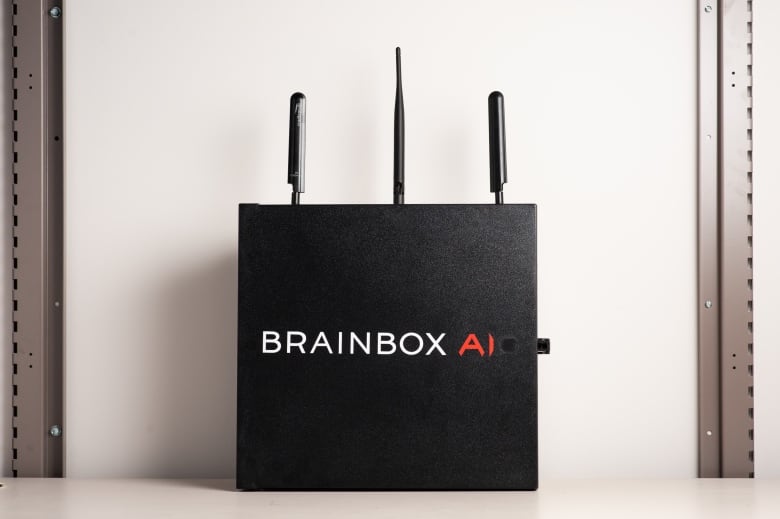Business
Canadian researchers using machine learning to mitigate effects of climate change – CBC News
After spending almost a decade working in computer science and artificial intelligence (AI), Sasha Luccioni was ready to uproot her whole life three years ago after she became deeply concerned by the climate crisis.
But her partner convinced her to not give up her career completely but instead apply her knowledge of AI to some of the challenges posed by climate change.
“You don’t need to quit your job in AI in order to contribute to fighting the climate crisis,” she said. “There are ways that almost any AI technique can be applied to different parts of climate change.”
She joined the Montreal-based AI research centre Mila and became a founding member of Climate Change AI, an organization of volunteer academics who advocate using AI to solve problems related to climate change.
- Do you have a question about climate change and what is being done about it? Send an email to ask@cbc.ca.


Luccioni is part of a growing community of researchers in Canada who are using AI in this way.
In 2019, she co-authored a report arguing that machine learning can be a useful tool for mitigating and adapting to the effects of climate change.
Computer scientists define machine learning as a form of artificial intelligence that enables computers to use historical data and statistical methods to make predictions and decisions without having to be programmed to do so.
Common applications of machine learning include predictive text, spam filters, language translation apps, streaming content recommendations, malware and fraud detection and social media algorithms.
Applications for machine learning in climate research include climate forecasting and optimization of electricity, transportation and energy systems, according to the 2019 report.
Preparing for crop diseases
Researchers at the University of Prince Edward Island (UPEI) are using AI modelling to warn farmers about risks to their crops as weather becomes more unpredictable.
“If you have a dry year, you see very little disease, but with a wet year, you can get quite a bit of disease around plants,” said Aitazaz Farooque, interim associate dean of UPEI’s School of Climate Change and Adaptation.


Researchers can plug weather data from previous years into an AI model to predict the type of diseases that might jeopardize crops at different times of the year, said Farooque.
“Then the grower can be a bit proactive and have an understanding of what they’re getting into,” he said.
WATCH | Take a look at UPEI’s School of Climate Change and Adaptation:
From the drones to the dorms, the state-of-the-art research facility in St. Peter’s Bay will have students and world-class researchers studying the many facets of climate change.
PEI’s agriculture is mostly rain fed, and providing farmers with more accurate rainfall predictions can also help them have more successful crop yields, said Farooque.
“With climate change, we are seeing different trends where the total cumulative rainfall doesn’t change much, but the timing matters,” he said.
“If it doesn’t happen at the right time, then the sustainability of our agriculture can be at risk.”
Studying behaviour around disruptive weather
Another application of AI is being studied at McGill University, where researchers are using historical and recent weather data to predict the social impacts of extreme weather events that are being affected by climate change, such as heat waves, droughts and floods.
According to Renee Sieber, an associate professor in McGill’s geography department, researchers are hoping to find out how people responded to disruptive weather events in the past and whether that can teach us anything about how resilient we will be in the future.


The team will use a form of AI called natural language processing to analyze social narratives related to weather events in newspapers and other media.
“The AI is very good for organizing, synthesizing, finding trends or some sentiment out of vast amounts of unstructured text,” said Sieber.
“Basically, what you do is throw journal articles into a bucket, and you see what comes out.”
Sieber said her team will take the findings from past articles and today’s social media and compare them with corresponding weather records to identify people’s responses to weather events over time.
Records from the McGill Observatory are the longest and most detailed uninterrupted written records of weather patterns in Canada and contain a massive amount of information, said Sieber. Weather recording there began in 1863 and continued into the 1950s.
“This data is the only direct measure of climate change that we have [in Canada],” said Sieber.
Optimizing energy use
Some Canadian companies are using AI to minimize waste and build more energy efficient infrastructure.
Scale AI, a Montreal-based investors group that funds projects related to supply chains, has worked with grocery chains such as Loblaws and Save-on-Foods to identifying purchasing patterns. Through AI, companies are able to better predict demand and less food items are going to waste, said Scale AI CEO Julien Billot.
“Every optimization we can achieve improves the resilience of supply chains and contributes to the use of less resources,” she said.
Another Montreal company, BrainBox Al, is focused on improving energy efficiency by optimizing HVAC systems in commercial buildings.
The machine-learning technology is contained in a 30 cm wide box that connects to a building’s HVAC system. It raises or lowers temperatures based on data inputs such as weather forecasts, utility prices and carbon-emission calculations.


The system has been able to cut energy consumed by some HVAC systems by 25 per cent, BrainBox CEO Sam Ramadori said, and over two years, the company has installed the technology in 350 buildings in 18 countries.
“The same kind of intelligence that we are bringing to buildings has probably an infinite number of applications. Just pick a sector,” Ramadori said.
“How we make cement, how we ship goods — all of those need to be made more efficient over time as part of the climate change fight.”
According to Ramadori, BrainBox AI is working on technology that will allow buildings to link up with each other and communicate with energy grids through the company’s cloud server.


This has the potential to minimize wasted energy on a city-wide scale as energy grids more accurately detect where and when power is needed, he said.
“The utility grid can say, ‘Hey, the next two hours are going to be busy. I need you to find a way we can reduce consumption.’ And with the AI brain up top, it’s able to say, ‘OK, I can reduce a bit here and a bit there. I’ve got you covered,'” said Ramadori.
Equity limitations to AI
Access to the kind of AI that can help solve climate-related problems is not equal across the globe.
Forest fires in North America, for example, tend to receive more attention from developers than locust infestations in East Africa, said David Rolnick, an assistant professor of computer science at McGill and a member of Mila.
“The way in which climate change impacts a community varies greatly between different geographies,” said Rolnick, who is also the chair of Climate Change AI.


AI technology relies on data sets, and many communities do not have access to enough of the kind of robust data needed to create machine-learning algorithms, Rolnick said.
In Canada, some Indigenous and remote northern communities still face significant digital divides compared with other parts of the country, he said.
“Working on democratizing that is fundamentally important,” Rolnick said.
Rolnick co-authored a study last year outlining various limitations to implementing AI for climate change solutions in Canada. It called for increased funding for AI research and more AI education in primary and secondary education as well as standards and protocols for data sharing related to climate projects.
Rapidly implementing large-scale AI literacy programs for policymakers and leaders in climate-relevant industries could help “demystify” AI, the report said.
“We often see a lack of relevant knowledge, and educational programs can help people understand what these tools can and cannot do,” said Rolnick.
Business
Bitcoin's latest 'halving' has arrived. Here's what you need to know – Business News – Castanet.net


The “miners” who chisel bitcoins out of complex mathematics are taking a 50% pay cut — effectively reducing new production of the world’s largest cryptocurrency, again.
Bitcoin’s latest “halving” appeared to occur Friday night. Soon after the highly anticipated event, the price of bitcoin held steady at about $63,907.
Now, all eyes are on what will happen down the road. Beyond bitcoin’s long-term price behavior, which relies heavily on other market conditions, experts point to potential impacts on the day-to-day operations of the asset’s miners themselves. But, as with everything in the volatile cryptoverse, the future is hard to predict.
Here’s what you need to know.
WHAT IS BITCOIN HALVING AND WHY DOES IT MATTER?
Bitcoin “halving,” a preprogrammed event that occurs roughly every four years, impacts the production of bitcoin. Miners use farms of noisy, specialized computers to solve convoluted math puzzles; and when they complete one, they get a fixed number of bitcoins as a reward.
Halving does exactly what it sounds like — it cuts that fixed income in half. And when the mining reward falls, so does the number of new bitcoins entering the market. That means the supply of coins available to satisfy demand grows more slowly.
Limited supply is one of bitcoin’s key features. Only 21 million bitcoins will ever exist, and more than 19.5 million of them have already been mined, leaving fewer than 1.5 million left to pull from.
So long as demand remains the same or climbs faster than supply, bitcoin prices should rise as halving limits output. Because of this, some argue that bitcoin can counteract inflation — still, experts stress that future gains are never guaranteed.
HOW OFTEN DOES HALVING OCCUR?
Per bitcoin’s code, halving occurs after the creation of every 210,000 “blocks” — where transactions are recorded — during the mining process.
No calendar dates are set in stone, but that divvies out to roughly once every four years.
WILL HALVING IMPACT BITCOIN’S PRICE?
Only time will tell. Following each of the three previous halvings, the price of bitcoin was mixed in the first few months and wound up significantly higher one year later. But as investors well know, past performance is not an indicator of future results.
“I don’t know how significant we can say halving is just yet,” said Adam Morgan McCarthy, a research analyst at Kaiko. “The sample size of three (previous halvings) isn’t big enough to say ‘It’s going to go up 500% again,’ or something.”
At the time of the last halving in May 2020, for example, bitcoin’s price stood at around $8,602, according to CoinMarketCap — and climbed almost seven-fold to nearly $56,705 by May 2021. Bitcoin prices nearly quadrupled a year after July 2016’s halving and shot up by almost 80 times one year out from bitcoin’s first halving in November 2012. Experts like McCarthy stress that other bullish market conditions contributed to those returns.
Friday’s halving also arrives after a year of steep increases for bitcoin. As of Friday night, bitcoin’s price stood at $63,907 per CoinMarketCap. That’s down from the all-time-high of about $73,750 hit last month, but still double the asset’s price from a year ago.
Much of the credit for bitcoin’s recent rally is given to the early success of a new way to invest in the asset — spot bitcoin ETFs, which were only approved by U.S. regulators in January. A research report from crypto fund manager Bitwise found that these spot ETFs, short for exchange-traded funds, saw $12.1 billion in inflows during the first quarter.
Bitwise senior crypto research analyst Ryan Rasmussen said persistent or growing ETF demand, when paired with the “supply shock” resulting from the coming halving, could help propel bitcoin’s price further.
“We would expect the price of Bitcoin to have a strong performance over the next 12 months,” he said. Rasmussen notes that he’s seen some predict gains reaching as high as $400,000, but the more “consensus estimate” is closer to the $100,000-$175,000 range.
Other experts stress caution, pointing to the possibility the gains have already been realized.
In a Wednesday research note, JPMorgan analysts maintained that they don’t expect to see post-halving price increases because the event “has already been already priced in” — noting that the market is still in overbought conditions per their analysis of bitcoin futures.
WHAT ABOUT MINERS?
Miners, meanwhile, will be challenged with compensating for the reduction in rewards while also keeping operating costs down.
“Even if there’s a slight increase in bitcoin price, (halving) can really impact a miner’s ability to pay bills,” Andrew W. Balthazor, a Miami-based attorney who specializes in digital assets at Holland & Knight, said. “You can’t assume that bitcoin is just going to go to the moon. As your business model, you have to plan for extreme volatility.”
Better-prepared miners have likely laid the groundwork ahead of time, perhaps by increasing energy efficiency or raising new capital. But cracks may arise for less-efficient, struggling firms.
One likely outcome: Consolidation. That’s become increasingly common in the bitcoin mining industry, particularly following a major crypto crash in 2022.
In its recent research report, Bitwise found that total miner revenue slumped one month after each of the three previous halvings. But those figures had rebounded significantly after a full year — thanks to spikes in the price of bitcoin as well as larger miners expanding their operations.
Time will tell how mining companies fare following this latest halving. But Rasmussen is betting that big players will continue to expand and utilize the industry’s technology advances to make operations more efficient.
WHAT ABOUT THE ENVIRONMENT?
Pinpointing definitive data on the environmental impacts directly tied to bitcoin halving is still a bit of a question mark. But it’s no secret that crypto mining consumes a lot of energy overall — and operations relying on pollutive sources have drawn particular concern over the years.
Recent research published by the United Nations University and Earth’s Future journal found that the carbon footprint of 2020-2021 bitcoin mining across 76 nations was equivalent to emissions of burning 84 billion pounds of coal or running 190 natural gas-fired power plants. Coal satisfied the bulk of bitcoin’s electricity demands (45%), followed by natural gas (21%) and hydropower (16%).
Environmental impacts of bitcoin mining boil largely down to the energy source used. Industry analysts have maintained that pushes towards the use of more clean energy have increased in recent years, coinciding with rising calls for climate protections from regulators around the world.
Production pressures could result in miners looking to cut costs. Ahead of the latest halving, JPMorgan cautioned that some bitcoin mining firms may “look to diversify into low energy cost regions” to deploy inefficient mining rigs.
Business
Dow Jones Rises But S&P, Nasdaq Fall; Nvidia, SMCI Flash Sell Signals As Bitcoin's Fourth Halving Arrives – Investor's Business Daily
[unable to retrieve full-text content]
- Dow Jones Rises But S&P, Nasdaq Fall; Nvidia, SMCI Flash Sell Signals As Bitcoin’s Fourth Halving Arrives Investor’s Business Daily
- Iran fires at apparent Israeli attack drones: Mideast tensions The Associated Press
- S&P 500 extends losing streak to sixth day, Dow up 210 points Yahoo Canada Finance
- Stock Market Today: Dow, S&P Live Updates for April 19 Bloomberg
- Stock market today: Wall Street limps toward its longest weekly losing streak since September CityNews Kitchener
Business
Netflix stock sinks on disappointing revenue forecast, move to scrap membership metrics – Yahoo Canada Finance
Netflix (NFLX) stock slid as much as 9.6% Friday after the company gave a second quarter revenue forecast that missed estimates and announced it would stop reporting quarterly subscriber metrics closely watched by Wall Street.
On Thursday, Netflix guided to second quarter revenue of $9.49 billion, a miss compared to consensus estimates of $9.51 billion.
The company said it will stop reporting quarterly membership numbers starting next year, along with average revenue per member, or ARM.
“As we’ve evolved our pricing and plans from a single to multiple tiers with different price points depending on the country, each incremental paid membership has a very different business impact,” the company said.
Netflix reported first quarter earnings that beat across the board on Thursday, with another 9 million-plus subscribers added in the quarter.
ADVERTISEMENT
Subscriber additions of 9.3 million beat expectations of 4.8 million and followed the 13 million net additions the streamer added in the fourth quarter. The company added 1.7 million paying users in Q1 2023.
Revenue beat Bloomberg consensus estimates of $9.27 billion to hit $9.37 billion in the quarter, an increase of 14.8% compared to the same period last year as the streamer leaned on revenue initiatives like its crackdown on password-sharing and ad-supported tier, in addition to the recent price hikes on certain subscription plans.
Netflix’s stock has been on a tear in recent months, with shares currently trading near the high end of its 52-week range. Wall Street analysts had warned that high expectations heading into the print could serve as an inherent risk to the stock price.
Earnings per share (EPS) beat estimates in the quarter, with the company reporting EPS of $5.28, well above consensus expectations of $4.52 and nearly double the $2.88 EPS figure it reported in the year-ago period. Netflix guided to second quarter EPS of $4.68, ahead of consensus calls for $4.54.
Profitability metrics also came in strong, with operating margins sitting at 28.1% for the first quarter compared to 21% in the same period last year.
The company previously guided to full-year 2024 operating margins of 24% after the metric grew to 21% from 18% in 2023. Netflix expects margins to tick down slightly in Q2 to 26.6%.
Free cash flow came in at $2.14 billion in the quarter, above consensus calls of $1.9 billion.
Meanwhile, ARM ticked up 1% year over year — matching the fourth quarter results. Wall Street analysts expect ARM to pick up later this year as both the ad-tier impact and price hike effects take hold.
On the ads front, ad-tier memberships increased 65% quarter over quarter after rising nearly 70% sequentially in Q3 2023 and Q4 2023. The ads plan now accounts for over 40% of all Netflix sign-ups in the markets it’s offered in.
Alexandra Canal is a Senior Reporter at Yahoo Finance. Follow her on X @allie_canal, LinkedIn, and email her at alexandra.canal@yahoofinance.com.
Read the latest financial and business news from Yahoo Finance
-
Media20 hours ago
DJT Stock Rises. Trump Media CEO Alleges Potential Market Manipulation. – Barron's
-
Media22 hours ago
Trump Media alerts Nasdaq to potential market manipulation from 'naked' short selling of DJT stock – CNBC
-
Investment21 hours ago
Private equity gears up for potential National Football League investments – Financial Times
-
Real eState13 hours ago
Botched home sale costs Winnipeg man his right to sell real estate in Manitoba – CBC.ca
-
News19 hours ago
Canada Child Benefit payment on Friday | CTV News – CTV News Toronto
-
Business21 hours ago
Gas prices see 'largest single-day jump since early 2022': En-Pro International – Yahoo Canada Finance
-
Art24 hours ago
Enter the uncanny valley: New exhibition mixes AI and art photography – Euronews
-



 Politics22 hours ago
Politics22 hours agoIran news: Canada, G7 urge de-escalation after Israel strike – CTV News





